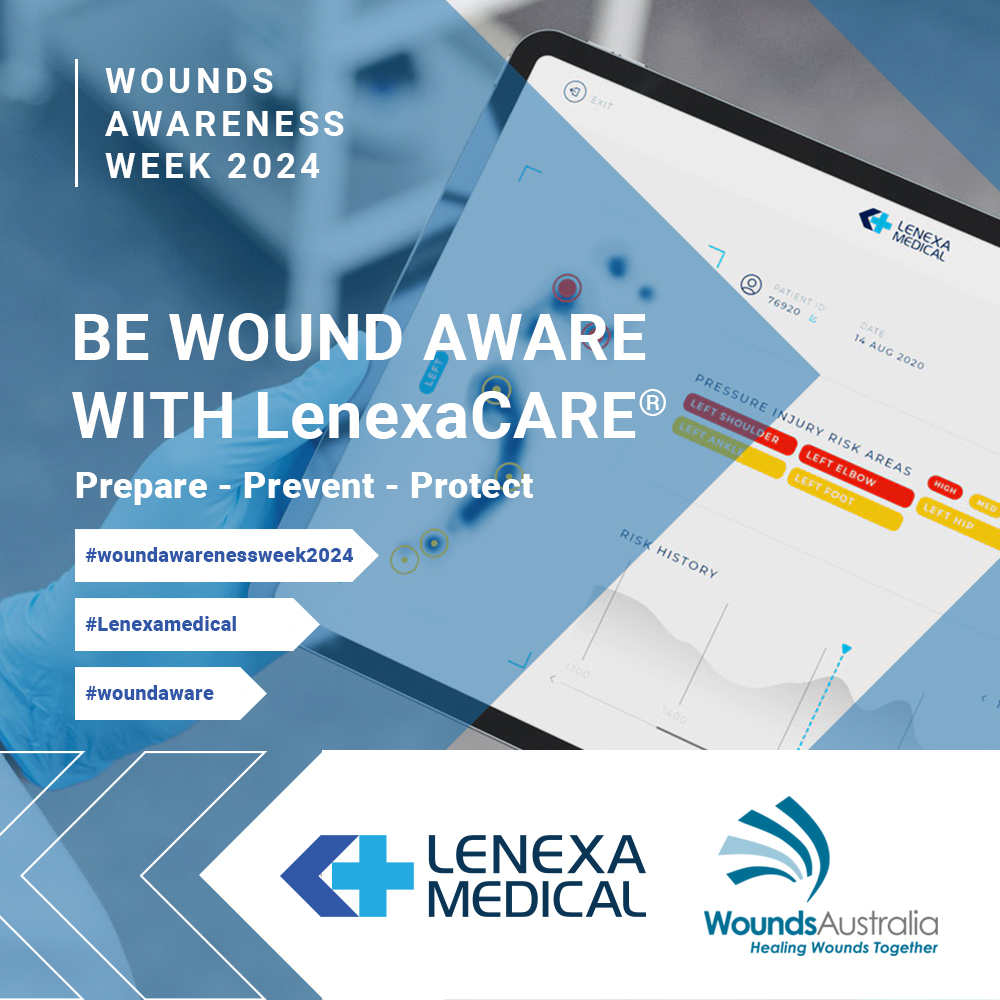
As we approach Wounds Awareness Week 2024, courtesy of Wounds Australia, Lenexa Medical is proud to shine a spotlight on a critical yet often overlooked health issue: chronic wounds and pressure injuries. This year, we’re inviting healthcare professionals and caregivers to “Be Wound Aware” with our innovative LenexaCARE® system, ensuring that no wound goes unnoticed or untreated. As we approach Wounds Awareness Week 2024, courtesy of Wounds Australia, Lenexa Medical is proud to shine a spotlight on a critical yet often overlooked health issue: chronic wounds and pressure injuries. This year, we’re inviting healthcare professionals and caregivers to “Be Wound Aware” with our innovative LenexaCARE® system, ensuring that no wound goes unnoticed or untreated.
The Hidden Epidemic of Chronic Wounds and Pressure Injuries
Did you know that over 450,000 Australians are living with chronic wounds? This silent epidemic not only causes significant discomfort and reduced quality of life for both hospital patients and aged care residents but also places a substantial burden on our healthcare system. According to Wounds Australia, chronic wounds cost the Australian healthcare sector more than $6 billion annually (Wounds Australia, 2024).Pressure injuries, a specific type of chronic wound, are localised damage to the skin or underlying tissue caused by intense or prolonged exposure to pressure, or often combined with tension or shear (International Guidelines, 2019). These injuries can present as intact skin or open wounds; and are especially prevalent in healthcare settings, affecting up to 18% of hospital patients and 28% of aged care residents (Australian Commission on Safety and Quality in Health Care, 2021).
Why Prevention is Key
Preventing pressure injuries is crucial for several reasons:
- Patient Comfort: Pressure injuries can be extremely painful and significantly impact a patient’s quality of life.
- Faster Recovery: Patients without pressure injuries typically have shorter hospital stays and faster rehabilitation.
- Cost-Effective: Prevention is far less expensive than treatment. The cost of treating a single pressure injury can range from $10,000 to $350,000 (Nghiem et al., 2022)
- Indicator of Care Quality: The incidence of pressure injuries is often used as a key indicator of nursing care quality.
LenexaCARE®: Pioneering Pressure Injury Prevention
At Lenexa Medical, we’re committed to the mantra of “Prepare, Protect, Prevent” when it comes to pressure injuries. Our LenexaCARE® system is at the forefront of this mission, offering a person-centred technology that empowers clinicians with real-time, personalised data to prevent pressure injuries before they occur.
The 3 Ps of LenexaCARE®: Prepare, Protect, Prevent
Prepare
- Personalised Monitoring: LenexaCARE® equips healthcare professionals with real-time data to prepare for patient needs. By continuously monitoring patient position and pressure points, the system enables caregivers to anticipate and address potential pressure injuries before they develop.
- Proactive Training: We help ensure that staff are well-trained in using LenexaCARE® technology and understanding the importance of regular repositioning to minimise risks.
Protect
- Real-Time Alerts: The LenexaCARE® system provides automated alerts to caregivers when a resident is at risk of developing a pressure injury. This proactive approach helps protect residents by ensuring timely interventions, increasing quality of life and overall efficiency.
- Data-Driven Decisions: With non-subjective data at their fingertips, carers can make informed decisions about residents’ care, effectively protecting vulnerable individuals from preventable injuries.
Prevent
- Comprehensive Care Strategies: LenexaCARE® facilitates the implementation of best practice pressure injury prevention measures tailored to each resident’s unique needs, significantly reducing the incidence of pressure injuries.
- Continuous Improvement: By utilising the insights gathered from LenexaCARE®, healthcare facilities can continuously refine their resident care strategies, ensuring that they are always aligned with the latest standards and practices in pressure injury prevention.
How LenexaCARE® Makes a Difference:
- Continuous Monitoring: Our fabric-based sensor technology provides 24/7 monitoring of patient position and pressure points, a crucial factor in pressure injury prevention (International Guidelines, 2019).
- AI-Powered Personalised Insights: Advanced algorithms to predict and prevent pressure injury development catered to resident physical position, fostering personalised intervention and pressure offloading aligned with international best practices (International Guidelines, 2019).
- Seamless Integration: LenexaCARE® integrates with existing systems, making it easy for healthcare providers to adopt and implement evidence-based prevention strategies.
Join Us
As we celebrate Wounds Awareness Week 2024, we invite healthcare professionals, caregivers, and individuals to join us in our mission to reduce the impact of chronic wounds and pressure injuries.
Together, we can make a significant impact on the lives of those affected by chronic wounds and pressure injuries. Let’s embrace Wounds Awareness Week and work towards a future where every wound is noticed, treated, and most importantly, prevented.
Reference
Nghiem, S., Campbell, J., Walker, R. M., Byrnes, J., & Chaboyer, W. (2022). Pressure injuries in Australian public hospitals: a cost of illness study. International Journal of Nursing Studies, 130(1), 104191. https://doi.org/10.1016/j.ijnurstu.2022.104191
Prevention and Treatment of Pressure Ulcers/Injuries: Clinical Practice Guideline. (2014). Internationalguideline.com. https://internationalguideline.com/
Wounds Australia. (2024). Wounds Australia Online Community. https://woundsaustralia.org/int/woundsaus/ocd.aspxAustralian Commission on Safety and Quality in Health Care. (2021). National Safety and Quality Health Service Standards. Australian Commission on Safety and Quality in Health Care.

